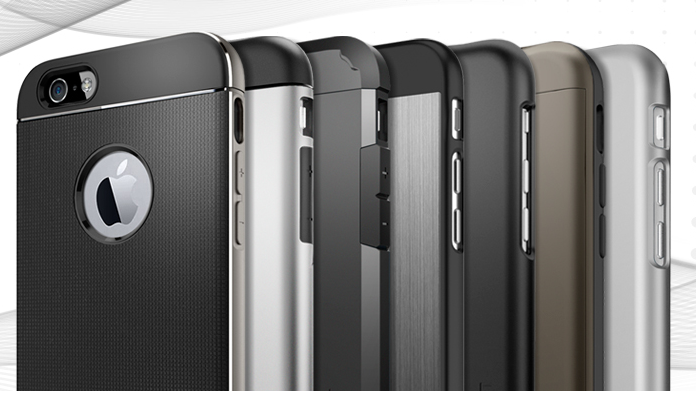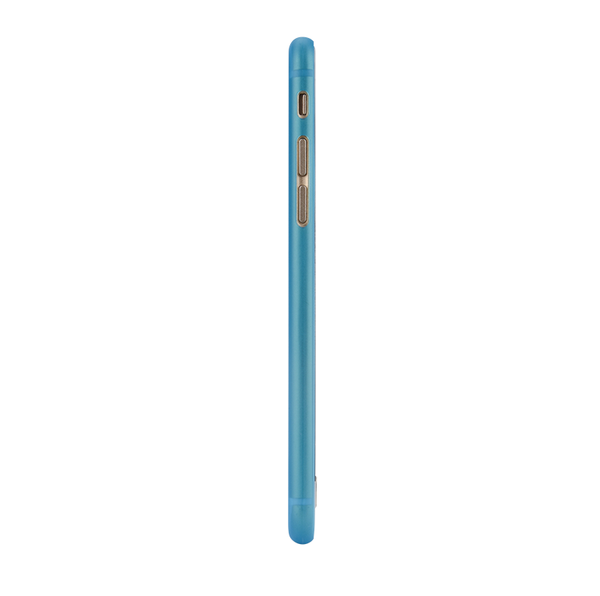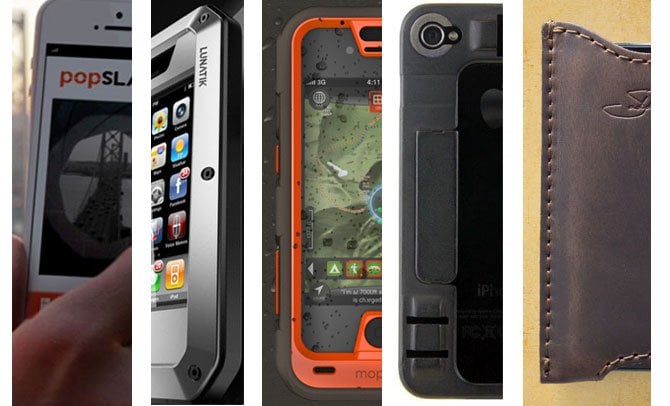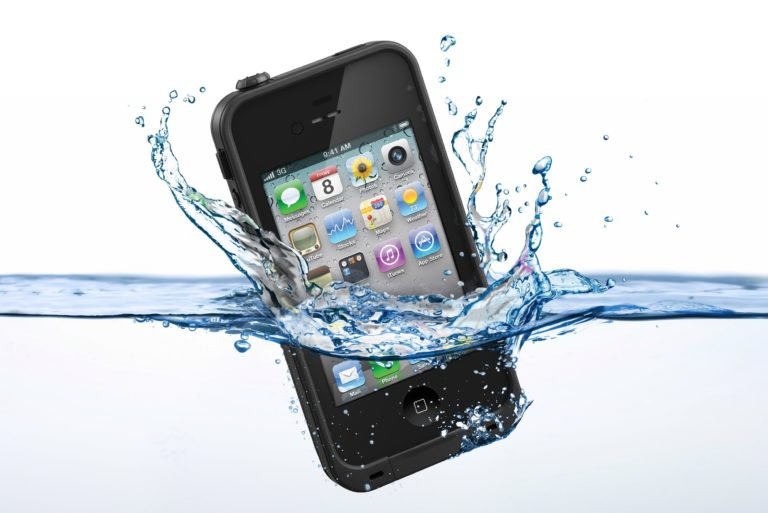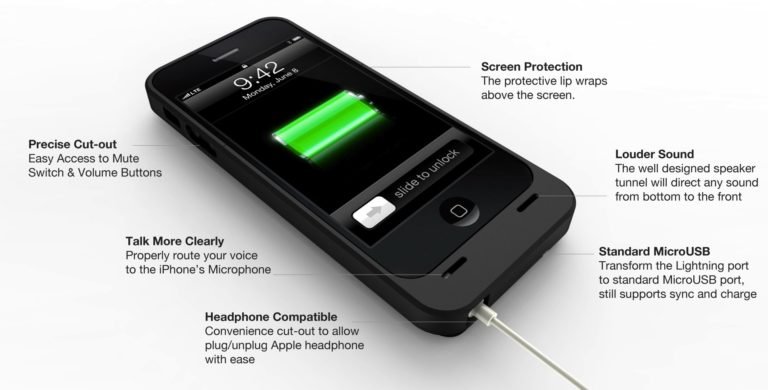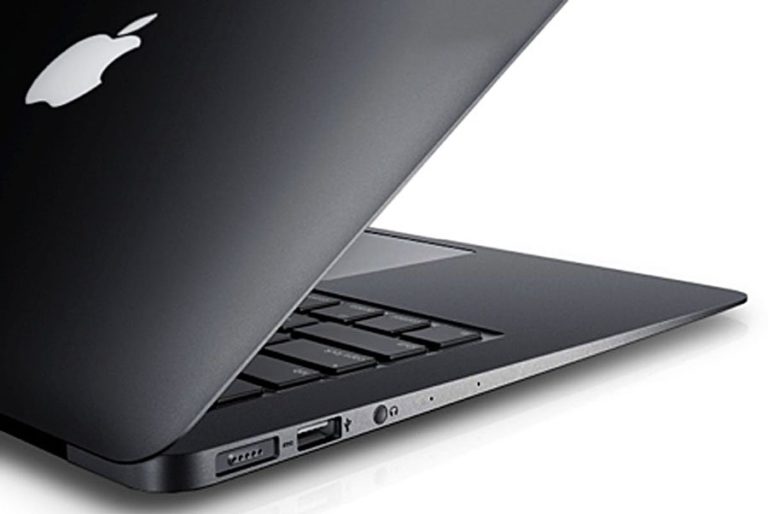Looking for The Best iPhone 6 Case?
Why use a case?
Unlike the iPhone 4/4s, the iPhone 5/5s’s perimeter band (the outer edge that includes the sleep/wake and volume buttons) is made of aluminum, which will nick from even a gentle drop. As with all iPhones, going caseless also leaves your screen somewhat vulnerable; screens are really tougher than they have any right to be because of Gorilla Glass technology, but you probably have a friend with a spider-cracked screen. For those who often throw their iPhone into a crowded handbag with potentially abrasive cargo, having a case and a screen protector (like that included with the Numbers) can keep a phone protected from scratches or from getting gunk in vital components, which can render the phone’s data ports and switches nonfunctional. iPhones are expensive items that travel with you everywhere and every day, so we think it’s worth investing in a case that will keep yours safe and fully functional. A case isn’t necessary by any means, but not sweating the daily abuse your phone is bound to take is a wonderful thing.
Another reason a lot of people use a case is to express a personal sense of style or humor. That’s perfectly valid, but we can’t really help you with that since it’s too much of a personal choice to figure out a “best style for most.” [see footnote 1]
What makes a good case?
The ideal case will insulate the phone against drops without compromising the iPhone’s brilliant design and simple ergonomics. Obviously, it’s impossible to protect the iPhone and keep the device’s composition entirely intact, but the exceptional cases we’ve found come close.
For this review, I looked specifically at slim, everyday-use cases, which offer plenty of protection against occasional drops. We see lots of people walking around with casesdesigned to protect against severe trauma, but that makes navigating the phone difficult and it’ll ruin the lines of a suit. A majority of iPhone owners don’t need a level of protection that greatly sacrifices ergonomics. For most owners, a case only needs to stand up to general use and abuse, like waist- or head-high drops onto concrete or a bouncy ride in a packed messenger bag. Once those requirements are met, you can look at the case’s aesthetics and overall fit.
If you ignore those requirements, you end up looking at a class of minimalist hardshell plastic cases that you’ve probably seen before. They clip to the back of the phone and expose every corner, the screen and the sides, and they provide only the barest of shock protection on the rear edges of the perimeter. We skipped looking at those, too—from our experience, if you’re comfortable with having your phone so open, you might as well go caseless and enjoy the full iPhone experience.
…one feature that separates the great from the good is the bottom lip edge that covers the Lightning port and headphone jack.
Now that we’re looking at cases within specific criteria, one feature that separates the great from the good is the bottom lip edge that covers the Lightning port and headphone jack. On most cases, one side of this band is too thin to stay in place and properly protect the phone. Great cases, we found, grip the iPhone snugly, never feeling flimsy or loose, feelings that can hurt both ergonomics and protective capabilities.
In addition to being protective, a case must be thin enough to never make basic operation difficult. This applies particularly to using the sleep/wake button, the vibrate on/off switch and the volume buttons. Many cases have recesses cut out to allow access to these buttons. Those cases require reaching around and pressing hard with your fingers to activate the switches, which is a pain when you use those buttons as often as we do. Great cases have covers for those buttons that spring back with the buttons to relay the responsive feeling you’d get from a bare iPhone. This, too, was a criterion for finalizing our picks.
Along with tactile feedback and coverage for these buttons, a good case must also allow access to all the plugs without obstructions that would require you to remove the case. Some third-party plugs were incompatible with our top picks, but as long as the included Apple Lightning cable could fit, we were satisfied.
The good news about the Lightning cable is that since it’s so narrow, cases can now put thick protection along the bottom. The old 30-pin models would be flimsy with thin strips of plastic. The best new models for the 5 and 5s are perforated for the speakers, which gives the case stability along the bottom without impeding cable plug-ins.
I don’t like using a screen protector because it always changes the iPhone screen’s responsiveness. That, and a good case should have a lip around the screen’s perimeter that rises up above the glass to protect the front if you lay the phone facedown. As we described, if you frequently stash your phone in a purse or messenger bag, a screen protector can be a good idea, and, if that’s you, the better cases we tested often come with one.
Narrowing it down
This took some doing. For this review, we picked out the best sources for iPhone gear reviews, sought out user reviews that showed intelligent criticism and read through your comments since our last version of this review.
In general, most iPhone case reviews have no actual reviewing. Roundups like this one from CNET or this one from Complex are basically lists of popular, attention-grabbing cases, with pickup art from the manufacturer’s website and a brief blurb without evidence of hands-on testing.
Our most trusted source and the initial qualifier for this review is iLounge. They scrupulously evaluate and test almost every case on the market. They take their own photos of the review units and pay attention to every feature of cases, including price. Their main accessories man (and Wirecutter contributor) Nick Guy has handled more iPhone 5 cases than anyone else in the world, and his reviews, which grade cases using an academic letter scale, let us eliminate cases that got under a B. To be absolutely sure, we checked professional assessments against any other reviews we could find, including Amazon user reviews, just to make sure we weren’t dismissing cases that have some hidden value or had been updated since their review.
We then combed Amazon for highly-rated cases that iLounge hadn’t reviewed and called them in or ordered them ourselves. These included everything from brand-name models that had loyal fans but hadn’t been popular enough to get formal reviews to brandless basic cases that appeared to be street vendor-quality in build but had hundreds of positive reviews.
…we researched over 100 cases, and personally tested close to 65 ourselves before deciding on our favorites.
Once we had a solid list of around fifty or so cases, we called them in to test ourselves. After my initial testing, which included drops with my iPhone inside, days spent walking and using the case casually, and applications of the cased phone to accessories like car mounts, I selected around a dozen finalists. I sent those to two of my editors who then tested those cases themselves independent of my notes to find which models overlapped as our favorites. From there, we compared notes and picked a winner.
Overall, we researched over 100 cases and personally tested close to 65 ourselves before deciding on our favorites.
If we missed any models that have enough feedback to be worth testing, tell us. If you think it is worth our time, hit us with suggestions in the comments or send them directly to me at alex[at]thewirecutter.com.
How we tested
After research of iLounge and Amazon’s cornucopia of available cases and collecting the first round of finalists for evaluation, I used the cases as if each were on my phone every day. I dropped them off the kitchen counter, from my pocket onto concrete, played Infinity Blade with them on, and solicited friends’ and strangers’ opinions on each models’ aesthetics. For the cases that are updates to previous-gen models, I researched past reviews to spot design updates and improvements, and to hold the iPhone 5 version to the standards of its antecedent. I also spoke with other expert reviewers to see what they’re personally using, which is telling of what makes a great case.
As mentioned, after using several dozen myself, I sent the top ten or so to my editors for their independent verification. After comparing notes on over a dozen finalists, we all agreed: the SwitchEasy Numbers is the best everyday iPhone case.
Our pick

The Switcheasy Numbers is our new favorite case because it takes everything we loved about our previous favorite, the Switcheasy Tones, and puts it in a more durable unibody design. They also added built-in port plugs, which is a nice touch.
Once again, SwitchEasy nails the fit of the iPhone 5/5s. It provides all the protection you need from light scuffs and drops while allowing the design and tactility of the iPhone 5/5s to show through. Small details, like a subtly matte finish and elevated buttons that are shaped like the ones on the actual iPhone, make it feel like you’re using a naked phone even though you’re still getting the protection of a case. Along the bottom, perforated speaker covers give the case added stability so it won’t bend or peel backwards below the home button.
Most unibody cases that are built like the Numbers are either made of gummy, slick and rigid TPU, or matte-but-stretchy silicone. SwitchEasy uses a polymer material that is rigid like TPU, but matte like silicone. It has a similar texture to the anodized aluminum back of an iPhone 5s, but without the cold, metallic feel of aluminum—a great balance between grip and smoothness. The material is also durable and shock-resistant. If you need to take the case off and flex it around, it’s pliable. That means it won’t snap if you apply and remove the case multiple times to use dock or large auxiliary/headphone cables.
Finally, the Numbers comes with attached plug covers for the headphone jack and Lightning port. SwitchEasy used to include these in older models, but they were very easy to lose—these are attached to the case so they won’t disappear. I’ve heard from multiple Apple Geniuses that they see many iPhone issues that come from foreign material getting into the ports, so using these convenient plugs is an added measure against damaging the phone.
We found that the AmazonBasics Lightning cable connector, which is significantly fatter than the official Apple cable, fits into the jack without trouble. Similarly, all but the most outdated and blunt headphone plugs will fit past the case into the headphone jack, something that can’t be said for many thicker cases out there.
Know that the Numbers definitely adds bulk to the phone, but of the literally dozens of cases we tested, it’s the thinnest, best-fitting model that still protects all angles of your phone and the screen.
As a point of comparison, the perennial favorite Speck CandyShell series is only about a millimeter longer in each dimension than the Numbers, but that’s enough to completely change the way you hold and interact with the phone. The Candyshell’s lip around the screen is abnormally tall, which means you’ll push against it when typing and swiping to unlock. Also the phone will be noticeably larger than normal in your pocket. The Numbers, on the other hand, has just enough thickness to protect from a drop while keeping the thin handfeel of the iPhone.
In the $15 package, SwitchEasy includes supplementary protection: a transparent front and back cover with a hard plastic squeegee for smoothing bubbles, a microfiber cloth. I got lots of use from the cloth, even for sunglasses.
Reviews of the SwitchEasy Numbers are scarce, so we handed one out to multiple Wirecutter editors for testing. We compared notes on everyday usability and durability, and it beat out every other case we’ve tried so far.
The only grievance we had was that it could fit just a bit tighter, but that’s just the nature of unibody cases. If it fits too tightly, then you won’t be able to get it on or off without a struggle.
As we’ve learned from readers and from our own testing, some of the Numbers are prone to discoloration — for example, going from clear to slightly blue from time in a jeans pocket. SwitchEasy has been mostly prompt about exchanges (see our long-term notes below), but we’ve heard enough complaints to warrant a warning. Most of us haven’t had an issue with the colors running, but it’s worth mentioning that $15 worth of plastic that we handle all waking hours of every day is susceptible to this kind of wear.
A note about authenticity
After reading hundreds of Amazon user reviews and reader comments, we saw complaints about the Numbers’ fit that none of our editors who have tested this case have ever noticed or taken issue with. We asked SwitchEasy about this, and they said that this is likely due to counterfeit cases being sold under the SwitchEasy name on Amazon and elsewhere. We made sure that our link is to the correct place, but now SwitchEasy tells us that they are planning to launch a new Amazon page. We’ve called customer service anonymously and kept up correspondence with our contacts there, but we can’t get a clear indication of when the store will open. Since we still can’t find a case that’s as all-around great as the numbers, we are linking directly to SwitchEasy’s site to ensure that no readers end up with fake cases.
Who else likes it
Nick Guy, Wirecutter contributor and case expert from iLounge.com, confirmed our suspicions and awarded the Numbers a straight “A” rating. That makes it iLounge’s best-rated iPhone 5 case. Aside from our own testing experience, seeing that the most respected iPhone accessory review site chose it as the best of all makes us all the more certain of the case’s overall greatness.
For comparison’s sake, Nick Guy gave the official Apple 5s leather case a “B” rating, stating that “[m]ost people will be better off with a less expensive or even better-designed plastic or rubber option, but we wouldn’t dissuade someone who prefers this more refined material from considering Apple’s option.”
If you have a 5c
Nick Guy named the Numbers for the 5c its best case so far, as well. He gave it the very rare “A” rating, which is exceptional for a $13 case. Nick gave Apple’s official 5c case a “B-“.
Also Great
Also Great

*At the time of publishing, the price was $26.
Designed by a firearms manufacturer, this case is designed to withstand a lot of abuse — and we appreciate that this toughness doesn’t come at the expense of excellent button response.
The Magpul Bump Case isn’t as svelte as the Numbers or Tones, but it’s exceptional because it is tougher than both cases and as ergonomically brilliant. It’s made by a firearms manufacturer, so the plastic exterior feels tough enough to survive a one-story drop. (We’re working on a standardized durability test for cases, check back soon.)
The proportions are exacting to the iPhone. It grips the exterior precisely, and the bottom cutouts for the speaker and ports are angled to not intrude on any of of the iPhone’s functionality. The rigid outer plastic is stiff so that it never shifts unless you’re inserting and removing your phone while the inner rubber layer provides better shock protection against small drops.
The exterior, like the SwitchEasy Numbers and Tones, has an exceptional matte finish that allows the phone to slide easily out of a pocket, while feeling assuringly grippy in-hand. The checkerboard ridges on the back of the case are borrowed from Magpul’s gun magazines — as you’d expect, a texture designed for reloading while under enemy fire works just as well when texting or playing Candy Crush.
Most impressive, though, is the attention to the button covers. Over the volume and the sleep/wake button, the plastic is textured so that you can easily find the buttons with your fingers. When depressing the volume or sleep/wake buttons, the covers transmit the subtle but essential click, then spring back to the correct position.
I’m also happy to report that it’s made in the USA for around $26.
iLounge likes it, too, and gave it a rare A- rating. Nick Guy said of it, “With an extra layer of protection, it’s going to ensure the iPhone remains safe from almost any physical damage it may see on an average day.”
Why isn’t it the best? It adds a bit more bulk to the phone than the Numbers or Tones and it has conspicuous branding on the back side, which slightly detracts from the iPhone’s otherwise clean lines. That extra size, however, makes it confidence-inspiring for protection. For people who ask me about getting an Otterbox, I tell them to get this case. It has all the protection you’d ever need without detracting from Apple’s creation of design and function. That’s important, and the Magpul achieves it, but at the cost of clean lines and a truly slim profile.
Magpul also makes the Field case for $17, which is a unibody rubber design. We don’t recommend this because the buttons are more difficult to press than with the Bump, which is just as lightweight and thin.
If Magpul’s military aesthetics aren’t your bag, we’ve always liked Speck’s form-fitting, highly protective CandyShell line, with the CandyShell Flip being our favorite, since it allows for easy, unfettered access to the ports when need be. iLounge has thoroughly reviewed the Grip and Edge models, and their argument for why the Flip is best won us over:
Unlike the CandyShell Grip or CandyShell Edge, the Flip’s bottom hatch makes it exceptionally easy to install and remove the phone, and since the bottom can be opened entirely, you’re guaranteed that all accessories, even the rare dock setup, will work. There are plenty of headphones out there with plugs that won’t fit through the opening on most cases. If you need to hardwire your phone to speakers, or a third-party charger, the Flip allows you to do that while retaining all the protection features that make the CandyShell great.
The glossy CandyShell exterior, unlike the Magpul’s, picks up scratches easily and adds a few more millimeters of bulk to the phone, both minor complaints that place it just below our other favorites.
Still, for $35 (often less), the Flip is an excellent option if the Magpul’s texture and colors aren’t to your liking.
If screen protection is a priority — for example, if you keep your phone in a purse — and you can spend a bit extra, the CandyShell + Faceplate for $45 is also great. The rigid screen protector, though it partially obstructs the home button, gives the screen more protection than the films that are included with some cases, like SwitchEasy’s, or the standalone stick-on protectors. As for the Speck Faceplate, as iLounge explains, “Thanks to cutouts that correspond to the Home Button on the bottom and camera, earpiece, and sensors on the top, lining the protector up is easy, and it’s more forgiving than standard films if you need to adjust it.”
For anyone who keeps their iPhone in a pocket, the Magpul Bump and CandyShell Flipare excellent options if you want more protection than the Numbers offers.
The Runner Up
Also Great
If you don’t plan on removing this case too often, this is a solid improvement over last year’s model.
With the addition of the attached plug protectors, this SwitchEasy Tones case is a major improvement over last year’s model (if you vehemently disagree, please read below before commenting or writing in). It still has the precise fit and svelte design that made us love the Tones since the iPhone 4. Its matte plastic and slick rubber are an exceptionally well designed balance of grip and the right slickness for ease when sliding in and out of a pocket. That material also hides scratches far better than the glossy plastic alternatives we’ve tested. The sleep/wake button cover provides excellent springback and relays the satisfying click when depressed. Same goes for the volume button covers.
The integrated plug covers on the bottom are, as with the Numbers, an excellent addition to this year’s model. They protect a vital area that can be a magnet for debris.
We want to recommend this case with one emphatic caveat: don’t use this if you plan to remove and reinsert your phone into the case often. As we’ve learned from reader responses and customer complaints, the plastic and rubber body style can break apart when strained repeatedly — although we’ve confirmed that some readers ended up with counterfeit cases that were more fragile. I’ve bent and torn multiple Tones and eventually needed pliers to separate the plastic from the rubber, but as we’ve learned from multiple sources, repeated insertions can cause the case to separate.
If you, like us, plan to keep your phone in the case for everyday use, the Tones is an exceptional design. It’s rigid, so it won’t bend around the edges, and its slim, so it adds no bulk. Add to that an included microfiber cloth and screen protector, and we’re sold.
The step down
Also Great

*At the time of publishing, the price was $4.
It’s cheap and does the job, but fits more loosely than is ideal. But it will work fine if you want the least expensive option.
If you really don’t want to spend $15 on the Numbers, the cheap-oAmazon Basics unibody case is only $3.50. It’s solid, but it fits more loosely than we’d like. We’d spend an extra $12 to get the Numbers, but the Basics is a decent option if you want to go super cheap or buy in bulk.
Rugged/waterproof cases
Also Great

*At the time of publishing, the price was $66.
The ATLAS is slim and fairly attractive for a rugged case but, most importantly, it was a top performer in each of our tests.
For light waterproof duty, tested to a quarter open water swim, some 8-foot dives and an overnight session in 6-feet of pool water, we liked the ATLAS by Incipio. But we have other rugged choices (including more heavy-duty cases) here.
What about other types of cases?
This time around we decided not to do separate sections for each type of case like wallet, clip-on, high-end, etc. But if that’s something you’d like to see included in this guide then let us know and we will put someone on it.
The competition
Due to the incredible scope of this product category, we’re going to do this a bit differently than you’d see in our other guides. Every case you see here has been tested by me, and a good portion of them were also reviewed by my editors, Brian Lam and Michael Zhao. We’ve broken these runners-up into categories of decreasing quality. First are the good cases—superb products but fall just short of our top pick. After that, we’ve listed cases have obvious flaws or are models that may be good, but are just too strangely-styled to appeal to most iPhone owners. A final section lists special-use cases that are made with niche appeal; though some will love them, they won’t fit the needs of most users.
Lesser but acceptable alternatives
Apple is also now selling their own iPhone case that is hard inside and has a leather exterior. While the aniline flat-color leather looks sharp and will potentially age well, we’re definitely not convinced that it is worth the $40 price tag. Nick Guy gave it a straight B rating, writing: “[m]ost people will be better off with a less expensive or even better-designed plastic or rubber option, but we wouldn’t dissuade someone who prefers this more refined material from considering Apple’s option.”
The idea behind Pong Research’s iPhone 5 case is to reduce the radiation from the phone and boost signal strength. The literature on the subject seems to validate Pong’s claims here and here. Still, $60 to $80 is a hefty sum for an iPhone case. I haven’t noticed a cranial sensitivity difference between this and the Switcheasy Numbers, but if you’re worried, the construction is solid, except for the recessed top and sides. Those make access to the buttons difficult. Don’t spend the extra cash unless you’re nervous about radiation.
Cellhelmet’s $50 iPhone 5 model is an unremarkable TPU case, but it comes with one year of accidental damage coverage. Once you register the case, you’re in. If you drop your iPhone 5 and crack the screen, you report that your phone’s busted, pay a $50 handling fee, and send it off. They’ll repair it and overnight it back to you. They’ll repair it as many times as you want and are willing to pay $50, but you get only one replacement. If you’re prone to dropping and breaking your iPhone 5 and don’t want to deal with insurance, the Cellhelmet system is worth considering. We’re waiting on delivery of a review unit to test out.
If you plan to watch a lot of video on your iPhone (though we don’t know why you would), ZeroChroma makes the best-rated kick-stand cases, which is what Nick Guy told us. We’d go with the Vario Protect, though at $40, it’s really steep.
Incipio, maker of our favorite waterproof iPhone case and a constant favorite of iLounge, has an excellent case called the NGP. It has the same design principle as the Numbers, but it needs to be just a bit tighter around the iPhone, and it could lose some bulk all around.
At just $18, the Spigen Armor uses the same design elements as the Numbers, and it works quite well. It’s heavier than the Numbers, though, and slightly thicker all around. The hole for the silent mode switch is very narrow. Because the whole case is thicker than the Numbers, it’s difficult to get to the switch without slim fingers. The lip meant to rise up and protect the screen is also too short, which diminishes protection.
The Belkin GripCandy Sheer has a near-ideal TPU blend, meaning the plastic exterior is the right balance between grippy and smooth. Nick Guy at iLounge likes it, too, but after extended use, we found the sleep/wake button to be less responsive than that on the Numbers. Macrumors users and Amazon reviews also show similar complaints. Besides that, we’ve noticed complaints that customers have been receiving the wrong color cases. The confusion appears to be that the images are from pre-production prototypes, which don’t match the current models. Again, everything the Grip Candy Sheer does, the Numbers does better, but if you really want one, go through Belkin’s site.
The Ballistic Aspira fits tightly around the phone, and the thicker corners provide good shock protection without bulking up the whole case. Know that the look isn’t for everyone and the slick back panel is quick to scratch. The specific model we liked to hold was the one with the rubberized honeycomb pattern on the back, which isn’t subtle. The biggest drawback that kept it from matching the Numbers was that the lip extends too far above the phone and gets in the way when typing and swiping.
If you want to express some style with your case, I was happily surprised by theRocketCase Retro Cassette Tape. For $15, it’s a TPU case that grips the iPhone well. The button covers preserve most of the spring feedback, but the design would look out of place at a meeting of the partners.
For anyone partial to the bumper that Apple made for the iPhone 4/4S, Photive’s Bumper Case for the 5 is a solid alternative for just $10. In testing, though, we found that even after a moderate break-in period, the sleep/wake button cover never felt completely responsive. It felt mushy to press, and it didn’t relay the satisfying click that comes through in the Numbers.
If you’re arborphilic, the aforementioned Grovemade Bamboo case is a great option. We tested a decal-style wood covering from Toast, liked the back panel, but had issues with the sides peeling. At just $5, they’re a decent temporary style accessory, but we wouldn’t depend on one for protection.
The rest
Throughout the aforementioned search process, we researched and hand-tested nearly one hundred cases.
Throughout the aforementioned search process, we researched and hand-tested nearly one hundred cases. Many companies we contacted for a specific highly-reputed model ended up sending multiple cases from their lineup, so we tested those, too. I applied the criteria I mentioned before—easy button access, little added bulk, solid protection and a good fit. After hands-on testing of the cases below, we found they didn’t clear the strict standards we’d set. Most of these don’t have formal reviews, so we went off of our personal testing and whatever user reviews we could find.
Elago S5 Outfit, Glide, and Slim Fit – thanks to the reader who mentioned these. Elago’s line is incredibly popular on Amazon (1,400-plus reviews for the Outfit), but at the same price as the Numbers, you get much less of a case. The bottom and top are entirely exposed, and there are no covers for the side buttons, so you need to push through the ring around them to use them. If, unlike us, you like a totally minimalist case that will save the phone from scuffs, it’s a solid option. The outer edge extends a millimeter or two above the screen, but don’t expect it to protect if the phone is laid face-down on an abrasive surface. Style-wise, they work — we didn’t like the Speck-style glossy finishes on some, but the white/Italian rose Outfit Matrix we tested looks great. These are solid for what they are, but don’t offer enough protection for us to recommend.
Tylt Band – best offering from Tylt, but too bulky for day-to-day use.
Tylt Sqrd – has love from iLounge, but is loose around the perimeter.
Tylt Bumpr – too bulky for everyday use.
Tylt Zig Zag – bottom partially covers the speakers.
Spigen Tough Armor – chunky, barely any button feel, and it’s getting into Otterbox territory for gratuitous protection at the cost of actual usability. The cutout for the Apple logo isn’t our style, either.
Speck SmartFlex – loose on the iPhone; we could hear it shaking around the phone.
Speck SmartFlex Shine – same looseness as SmartFlex. It also comes off the phone with minimal effort.
Speck SmartFlex Card – wallet-style case that works, but most don’t need the functionality, which only adds bulk and weight.
Speck View – kickstand style that works, but we like ZeroChroma’s sturdy and variable kickstand better.
Speck FabShell – a thick rim and small sleep/wake button add bulk.
Speck’s PixelSkin – textured TPU casing that absorbs shock like rubber but won’t stick to every surface. Unfortunately, the top and bottom rims aren’t quite snug against the phone, which causes the corners to bend back. The recess for the sleep/wake button also makes it more difficult to press than if the case had covers for the switch.
Incipio Stowaway – has a flap in the back that lets you hold credit cards and a driver’s license, but in our testing the case would open too easily and made an otherwise solid case feel a bit hollow and fragile.
Incipio Kicksnap – same as Speck View, not as good as ZeroChroma, only adds bulk.
Incipio Frequency – has a great fit, but the rubber is too sticky.
Incipio Stashback – like the Stowaway it’s made for storing cards, but it feels more hollow and fragile than the Stowaway.
Incipio Ovrmld – has a solid TPU backing, but the sleep/wake button is squishy.
Incipio Lgnd – a flap-style folio case that makes it difficult to use the phone quickly. Also more bulk than we need.
SwitchEasy Freerunner – has the brand’s signature fit quality, but we found it to be an in-between style case. The plastic screen protection and thick back make it bulky, though able to withstand a lot of abuse. For us, it’s a bit too large for everyday use. We also thought the two-toned circle aesthetic was just plain ugly.
Griffin Protector – floppy, loose-fitting case that’s good against impact, but sticks to the insides of pockets and adds lots of bulk.
SwitchEasy Colors – also floppy style, but has a great home button. Still, too much bulk for everyday use.
Amzer Silicone Skin Jelly – bends back and off the phone too easily.
Monoprice TPU Case – the hole for the headphone jack is narrow and deep so that it’s hard to fit all except the thinnest plugs — an old pair of Etymotics barely made enough contact to get sound, and not enough contact to make the volume controls functional. The outer polycarbonate shell also feels as cheap as it is.
Ballistic Smooth – great case, but discontinued.
Ballistic Hard Core – also discontinued, replaced by the Aspira.
Belkin Flex Case – covers the home button inconveniently, and the sticky exterior is too grippy for everyday use.
Case-Mate Barely There – cutout for buttons makes using it more difficult than the Numbers, and feels fragile.
Case-Mate Tough – covers the bottom speakers and is loose around the phone.
Case-Mate Naked – another minimalist-style case that doesn’t protect the front corners. Also typically fragile for the brand.
Case-Mate Glam – also fragile-feeling, has no shock protection, and way overpriced at $40. Sparkles are also unprofessional.
STM Opera – STM, maker of one of my favorite iPad cases, has decent cases, but the Opera has cutout side buttons and is loose around the bottom.
STM Harbor – has a flip-down bottom that lets you slide the phone into the top section of the casing, then close it shut. The design lets the phone sit more securely in the casing than with the Opera. But, also like the Opera, the Harbor also hides all the buttons in recesses, making them difficult to press.
Belkin ViewCase– good value at $20, but the clear rear film shows fingerprints clearly and gets scratched by dirt. If you were a fan of Apple’s iPhone 4 Bumper, this model is similar.
Poetic Atmosphere – volume and sleep/wake buttons are responsive, but the bottom cut-out for the Lightning port has no cross braces, which means the bottom lip flexes.
SYSTM Chisel – SYSTM (a subsidiary of Incase) uses PORON XRD, a sophisticated material that’s made of “high performance molecules that form a protective shell that can absorb up to 90% of the most intense force, As measured according to ASTM-F1614-C.” Chisel is too bulky for everyday use for us.
SYSTM Hammer – lip rises high above the edges and causes you to tap against it whenever sliding to unlock.
SYSTM Vise – enormous, Otterbox-style build, but it’s $50 for protection that’s not worth the bulk.
Griffin Reveal – works almost exactly the same as the Belkin ViewCase, and the rear smudges similarly.
Griffin Protector – the best of the silicone-padded models we’ve tried, but the material, while keeping it safe from severe drops, makes it a pain to remove from a pocket.
Incase Slider – a regular on Apple Store shelves, this brand makes the most basic (and least durable) cases of the bunch. Their Slider model is exactly what it sounds like. Pull off the bottom, slide in the phone, and slide the bottom back on. The only good thing is the easy installation. Besides that, the recesses for the buttons make them difficult to press, and the plastic feels so flimsy that it makes the phone itself feel cheap and brittle. When I pushed down the sleep/wake button, the phone always slid down and pushed the case ends apart.
Incase Snap – doesn’t have that same problems as the Slider, but it’s made of the same cheap-feeling plastic.
Cygnette WorkMate – the dual-construction on this case is high-intensity and Otterbox-style. iLounge likes it, but it’s too big for us to call it something we’d use everyday.
Hard Candy Shock Drop – it’s heavy-duty and made for hard drops, which means it’s also too big to use every day. The silicone will turn your pockets inside-out as well.
Id America Cushi Plus – iLounge found they make a solid case with good protection, but they only come with flashy designs that’d be out of place anywhere professional.
Skech Kameo – has a soft fabric back that adds thickness that we don’t think is necessary. The design also isn’t what we’d call understated.
Otterbox Defender – these are everywhere, but the protection is unnecessary and kills the utility of an iPhone with enormous construction. The $50 price is too much for us, too, and if you’re looking for really rugged protection, we’d spend an extra $25 on theOtterbox Armor for crushproof and waterproof protection.
Otterbox Commuter – like the Defender, these cases’ ubiquity come partially from their incredibly diverse distribution. The Commuter is similarly oversized, and its rubber exterior makes it stick to your pocket.
Otterbox Reflex – again, overprotective and adds way more bulk than is necessary for most people. We’re also not fans of two-piece slider cases like this.
Otterbox Prefix – this is the smallest and least-obtrusive of the Otterbox cases, but it’s still larger than the Numbers, and the sleep/wake button doesn’t have the spring-back we like in other cases.
What to look forward to
Our biggest issue with Otterbox cases is the unnecessary added heft, but at CES the company has introduced a new line of cases that might not actually be too bulky or excessive. The Symmetry series ($40 – $45) will fit the iPhone 5s and 5c and are made to be protective while also being one of the thinnest cases the company makes. We’ll have to try it out to see if this can overcome the shortcomings that have plagued other Otterbox models though.
Wrapping it up
After using all of the best-ranked cases available, we’d get the SwitchEasy Numbers. We simply can’t find a better balance of protection and everyday usability, all for ~$15.
Long-term test notes
Since hearing complaints from readers, we’ve kept our eyes open for discoloration in the Numbers. Wirecutter editors and co-testers have also found that the Frost White iPhone 5/5S case is prone to this — for editor Michael Zhao, that color case turned a blue-ish green from his jeans after weeks of use, while friends with the Stealth Black color had no such issue. That’s disappointing, but because the Numbers is a $15 piece of plastic that most people will use rigorously every waking hour of most days, we don’t hold the Frost and others’ discoloration as a strike against the Numbers’ quality. If you’re worried about this, we’ve had no issue with the Stealth black and other darker colors.
We contacted Switcheasy about these discoloration complaints, and a company spokesman told us, “Switcheasy stands behind all of its product and we will certainly replace any Switcheasy case that has a discoloration issue.” The company also noted that any kind of plastic will discolor over time due to “exposure of plain air (oxidation) and exposure to sunlight” but that Switcheasy UV treats its products to lessen and delay that effect. So far, SwitchEasy has handled returns promptly, but this appears to be an issue that goes beyond a potential “bad batch” of cases. If you are going with a bright color or clear case, consider that frequent exposure to a jeans pocket may have this effect.
Footnotes
1) Honestly, I can be very superficial, and plenty of us here love gear that puts panache before practicality. I write in my DODONotes with my fountain pen instead of using Evernote. Joel Johnson, editor emeritus of the Sweethome, loves the $70 Grove Bamboo case. It provides ample shock protection, is ethically sourced, made in the USA and is beautiful. But it’s not for everyone—the Bamboo adds plenty of size to the phone, and the side buttons are recessed and difficult-to-reach. I also love the $200 Element Ronin that I often use. It’s made of special dark wood and looks steampunk cool, but you need a special allen wrench to take it on or off.
Maybe you’re into that, but we figure a lot of people aren’t drawn to conspicuous exteriors or three-figure prices. Therefore, we’ve classified these types of style-specific cases as outliers. This piece is focused on reasonably priced, ergonomic and fully functional iPhone cases that, after all our collective hours of research, we’d readily recommend to a friend.
 Also read – Picasa: Free Download for Windows and Mac
Also read – Picasa: Free Download for Windows and Mac


